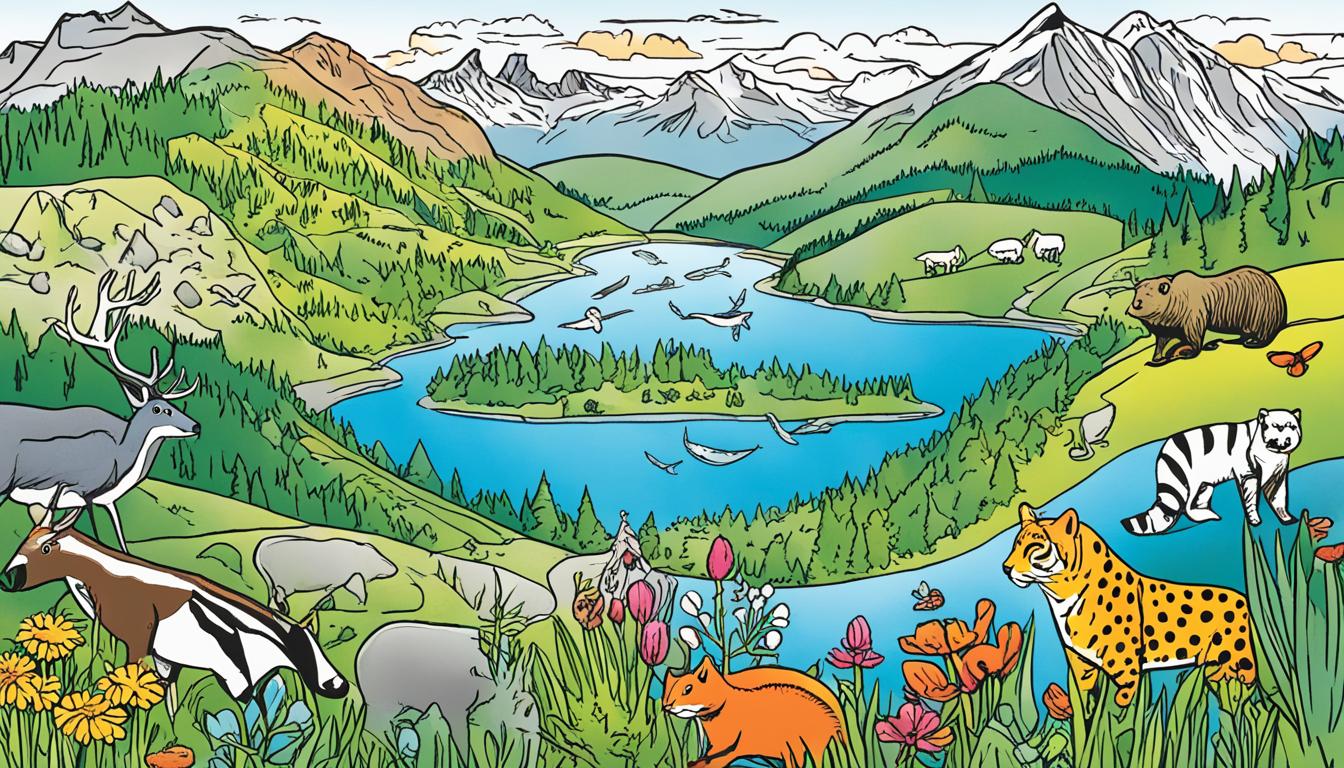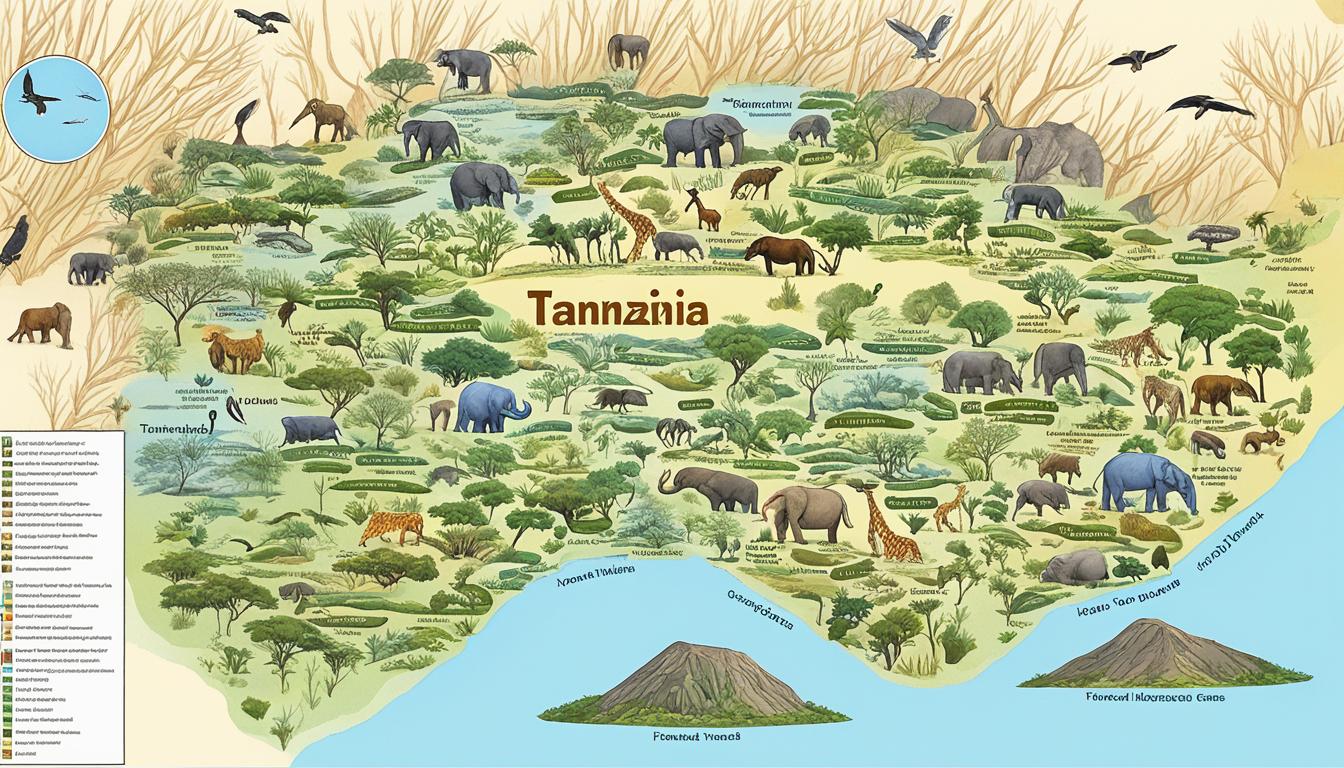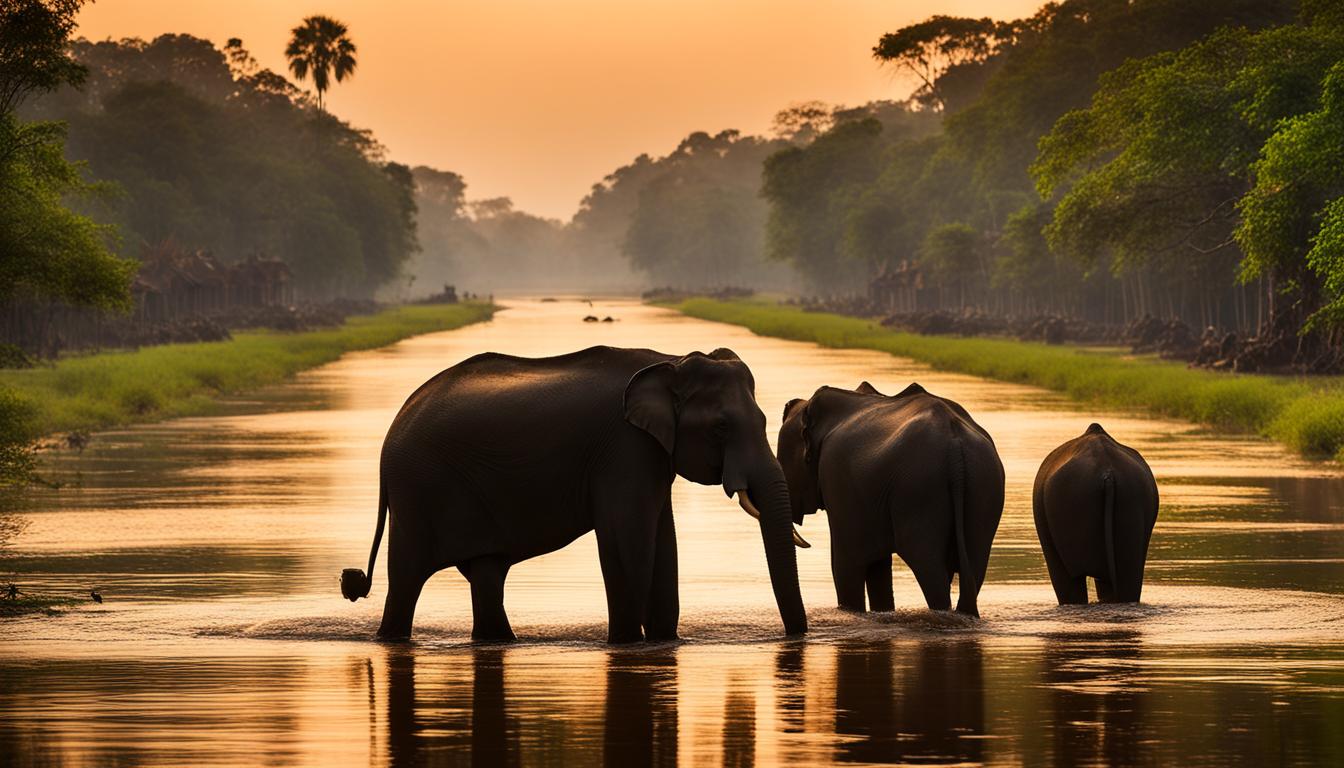Syria Biodiversity: Animal and Plant Species and What Is Under Threat
Did you know that Syria is home to a staggering diversity of animal and plant species, making it a true biodiversity hotspot? With its unique ecosystems and vast natural resources, Syria’s wildlife and plant life are of immense value. However, this rich ecological heritage is facing numerous threats that jeopardize its survival. Let’s explore the remarkable biodiversity of Syria, the challenges it faces, and the conservation efforts in place to protect these precious natural treasures.
Key Takeaways:
- Syria is a biodiversity hotspot with a diverse array of animal and plant species.
- The country’s flora includes various types of trees, shrubs, herbs, and grasses.
- Endemism is a significant feature of Syrian flora, with unique plant species found nowhere else.
- Insects, amphibians, reptiles, birds, and mammals form the diverse fauna of Syria.
- Syria has rich marine and freshwater biodiversity, supporting a wide range of species.
Flora of Syria
The flora of Syria showcases remarkable diversity, comprising a diverse array of plant species. From towering trees to vibrant shrubs, delicate herbs, and resilient grasses, the components of Syrian flora encompass a wide range of vegetation. However, the forests in Syria face significant challenges that have resulted in the decline of forest cover and biodiversity.
Endemism is a remarkable feature of Syrian flora, with several plant species being exclusive to Syria and not found anywhere else in the world. This makes the preservation and conservation of Syrian flora crucial for safeguarding these unique and irreplaceable botanical treasures.
To visualize the components of the Syrian flora, here’s a table highlighting some key plant species found in Syria:
| Plant Type | Examples |
|---|---|
| Trees | Olea europaea (Olive tree), Quercus infectoria (Oak tree), Pinus brutia (Aleppo pine) |
| Shrubs | Pistacia vera (Pistachio), Cistus creticus (Rockrose), Rosmarinus officinalis (Rosemary) |
| Herbs | Mentha spicata (Spearmint), Thymus vulgaris (Thyme), Melissa officinalis (Lemon balm) |
| Grasses | Hordeum vulgare (Barley), Avena sativa (Oats), Poa trivialis (Rough meadow grass) |
Fauna of Syria
The fauna of Syria is incredibly diverse, with a wide array of animal species calling this country home. From insects to mammals, Syria boasts a rich variety of wildlife that contributes to the nation’s biodiversity. Let’s explore some of the fascinating fauna that can be found in different habitats across Syria.
Insects
Insects play a vital role in pollination and ecosystem functioning. Syria is home to a diverse range of insects, including bees, butterflies, and beetles. These tiny creatures contribute to the reproduction of plants and the overall balance of the ecosystem. They are essential for maintaining healthy and flourishing habitats.
Amphibians and Reptiles
Syria’s habitats are also inhabited by various amphibians and reptiles, adding to the country’s fauna diversity. Salamanders and turtles are some of the amphibians and reptiles that can be found in Syria. These fascinating creatures occupy different ecosystems and contribute to the overall ecological balance.
Birds
Syria is a birdwatcher’s paradise, hosting a wide variety of bird species year-round, as well as serving as a stopover for migratory birds along their arduous journeys. From majestic eagles soaring in the sky to colorful songbirds perched on tree branches, there is a bird species for every enthusiast to admire. The avian diversity in Syria adds to the country’s natural charm.
Mammals
The mammalian population in Syria is diverse and includes species such as foxes, wolves, and gazelles. These mammals inhabit different regions, adapting to their respective environments. They are an integral part of Syria’s fauna and contribute to the overall balance of ecosystems.
Exploring the fauna of Syria reveals the abundance and significance of its wildlife. From the vital role of insects in pollination to the majestic presence of birds and mammals, Syria’s fauna reflects the country’s ecological richness.
“The richness and diversity of Syria’s fauna highlight the importance of protecting and conserving these natural treasures for future generations to enjoy.”
| Animal | Description |
|---|---|
| Insects | Bees, butterflies, beetles |
| Amphibians | Salamanders |
| Reptiles | Turtles |
| Birds | Resident and migratory species |
| Mammals | Foxes, wolves, gazelles |
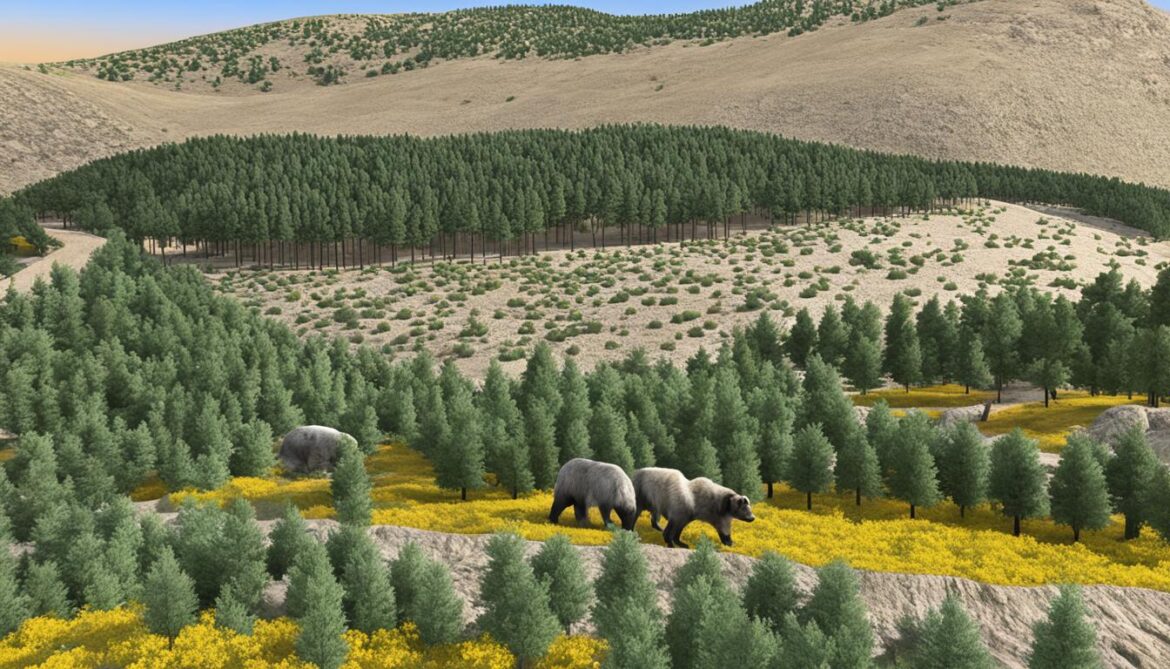
Aquatic Biodiversity
Syria is blessed with a remarkable diversity of aquatic ecosystems, encompassing both marine and freshwater habitats. The marine biodiversity of Syria is teeming with a wide array of marine flora and fauna, making it a vibrant and thriving ecosystem. The coastal areas of Syria provide a unique habitat for countless marine organisms, contributing to the overall richness of marine biodiversity in the region.
However, Syria’s aquatic biodiversity extends beyond its coastal regions. Inland, the country boasts a wealth of freshwater biodiversity, with its rivers, lakes, and wetlands acting as havens for diverse flora and fauna. These freshwater ecosystems harbor a variety of plant and animal species, contributing significantly to Syria’s overall biodiversity.
The conservation of these remarkable aquatic ecosystems is of paramount importance for Syria’s biodiversity and ecological balance.
The Importance of Marine Biodiversity
Marine biodiversity plays a crucial role in sustaining life on Earth. It provides us with valuable resources, such as food, medicines, and livelihoods. Moreover, marine ecosystems contribute to climate regulation, carbon sequestration, and the generation of oxygen. Protecting and conserving marine biodiversity is not only vital for the health of marine ecosystems but also essential for the well-being and sustainability of human societies.
The Beauty of Freshwater Biodiversity
Freshwater ecosystems are equally important, showcasing their own unique beauty and significance. Rivers, lakes, and wetlands support a diverse range of plant and animal life, including aquatic plants, fishes, amphibians, reptiles, and birds. These ecosystems are not only visually captivating but also function as critical corridors for migrating species, promoting genetic diversity and sustaining ecological processes.
Let us dive deeper into the world of Syrian aquatic biodiversity, exploring the marine and freshwater flora and fauna that inhabit these remarkable ecosystems.
“The future of our planet depends on the responsible conservation and management of marine and freshwater resources.” – Notable environmentalist
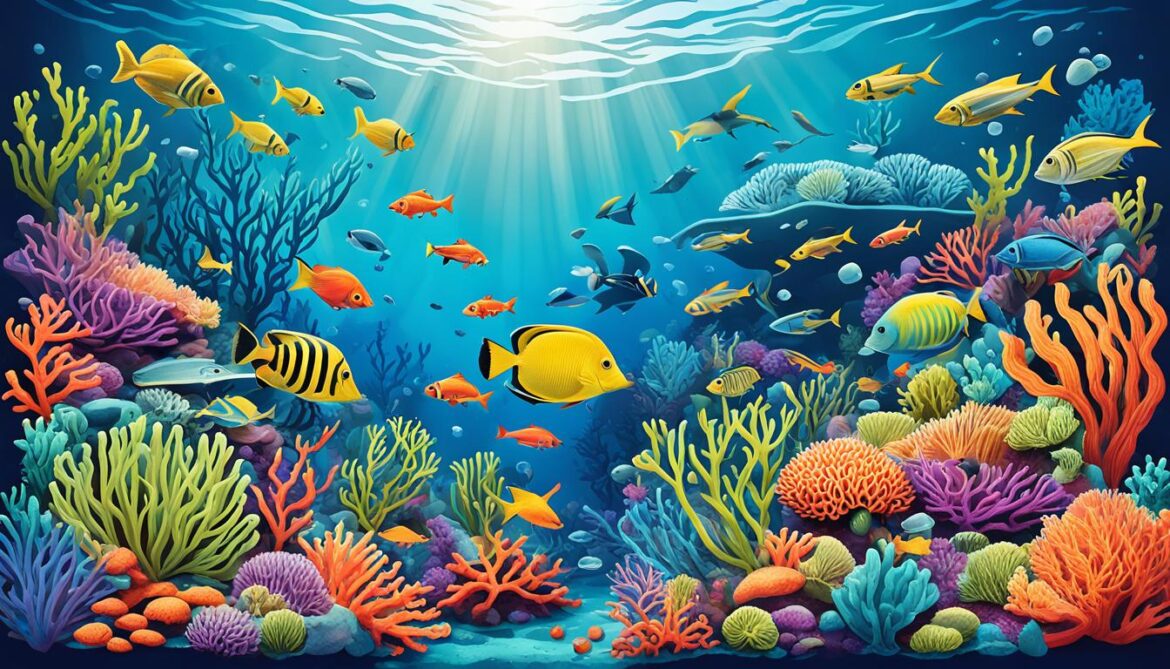
| Marine Biodiversity | Freshwater Biodiversity |
|---|---|
|
|
Biodiversity Threats in Syria
Despite the rich biodiversity in Syria, the country faces numerous threats to its ecological balance. The diverse ecosystems of Syria are vulnerable to various factors that endanger the survival of species and the stability of habitats.
Forests Threats
The forests in Syria are under significant threat due to deforestation, logging, and wildfires. These activities contribute to the loss of forest cover and the destruction of valuable habitats. Moreover, illegal logging and unsustainable practices exacerbate the degradation of forests, leading to biodiversity loss and ecosystem disruption.
Steppe Threats
The steppe regions of Syria, including marginal areas, are also experiencing degradation and habitat loss. Overgrazing by livestock, uncontrolled agricultural expansion, and improper land management practices contribute to the deterioration of the steppe ecosystems. This not only affects native vegetation but also disrupts the delicate balance of the ecological community.
Aquatic Biodiversity Threats
The aquatic biodiversity in Syria is particularly vulnerable to pollution, overfishing, and habitat destruction. Industrial pollution and agricultural runoff contaminate rivers, lakes, and coastal areas, endangering the survival of many aquatic species. Additionally, overfishing can disrupt food chains and lead to the decline of important fish populations. The destruction of aquatic habitats, such as wetlands, further threatens the delicate balance of these ecosystems.
Wildlife Threats
The wildlife in Syria faces numerous threats as well. Hunting and poaching pose a significant risk to various animal species, putting pressure on their populations. Additionally, habitat loss due to human activities, such as urbanization, agriculture, and infrastructure development, further endangers wildlife habitats. These threats combined contribute to the decline in the number and distribution of wildlife in Syria.
Addressing these biodiversity threats is crucial for the sustainable future of Syria’s ecosystems. Conservation efforts, sustainable land management practices, and the protection of key habitats are necessary to protect the country’s rich biodiversity and ensure the survival of its unique species. It is essential to raise awareness and foster collaboration at local, national, and international levels to mitigate these threats and promote the preservation of Syria’s natural heritage.
Conservation Efforts in Syria
Syria has demonstrated a strong commitment to conserving its rich biodiversity through various initiatives and projects. These conservation efforts play a vital role in protecting and preserving the country’s unique ecosystems, species, and natural resources.
Protected Areas
In line with its commitment to biodiversity conservation, Syria has designated several protected areas throughout the country. These areas include national parks, nature reserves, and biosphere reserves, which serve as crucial habitats for a diverse range of plant and animal species. By establishing these protected areas, Syria aims to safeguard important biodiversity hotspots and their associated ecological functions.
Biodiversity Conventions
Syria has actively participated in regional and international biodiversity conventions to enhance its conservation efforts. By joining these conventions, including the Convention on Biological Diversity (CBD), Syria demonstrates its commitment to promoting global biodiversity conservation and sustainable development. Engaging in international dialogue and collaborations allows Syria to share experiences and learn from the best practices of other countries.
Conservation of Plant Genetic Resources and Agro-biodiversity
Recognizing the importance of preserving plant genetic resources and promoting agro-biodiversity, Syria has implemented conservation projects in these areas. These projects focus on maintaining the diversity of plant species, protecting traditional agricultural practices, and preserving local knowledge related to plant genetic resources. By promoting sustainable agriculture and protecting agro-biodiversity, Syria ensures food security and the preservation of valuable genetic traits in crops.
“Syria’s conservation efforts encompass protected areas, biodiversity conventions, and projects focusing on plant genetic resources and agro-biodiversity. These initiatives contribute to the preservation of Syria’s natural heritage and support sustainable development.”

| Efforts | Description |
|---|---|
| Protected Areas | Syria has established national parks, nature reserves, and biosphere reserves to protect important habitats and species. |
| Biodiversity Conventions | Syria actively participates in international and regional biodiversity conventions to enhance conservation efforts. |
| Plant Genetic Resources | Conservation projects focus on preserving plant genetic resources and promoting agro-biodiversity. |
Progress on Biodiversity Strategies and Action Plans
Syria is dedicated to the conservation of its natural resources and has developed comprehensive biodiversity strategies and action plans to guide its efforts. These plans encompass national priorities for the execution of the Convention on Biological Diversity (CBD) and aim to integrate biodiversity considerations into various sectors.
The implementation of the CBD is a significant milestone for Syria’s biodiversity conservation. The country has diligently prepared national reports and established a national committee specifically focused on biodiversity. By actively engaging in the CBD execution, Syria demonstrates its commitment to safeguarding the country’s unique ecological heritage and ensuring the long-term sustainability of its ecosystems.
Integration of Biodiversity in National Policies and Plans
Syria recognizes the critical importance of integrating biodiversity into national policies and plans. By incorporating biodiversity considerations, the nation aims to strengthen conservation efforts and promote sustainable development. The development and implementation of national action plans are key steps towards achieving these goals.
“The integration of biodiversity considerations in national policies and plans is crucial for the conservation of our natural resources and the promotion of sustainable development,” says Dr. Samir Hasan, Minister of State for Environmental Affairs in Syria.
Progress on Biodiversity Strategies and Action Plans in Syria
| Biodiversity Strategies | Action Plans | National Priorities |
|---|---|---|
| Development of comprehensive strategies to conserve biodiversity and protect ecosystems | Implementation of specific actions to achieve conservation targets | Identification of priority areas and species for conservation efforts |
| Integration of biodiversity considerations into national policies and plans | Establishment of monitoring and evaluation mechanisms | Building capacity for effective biodiversity management |
| Promotion of sustainable use of biodiversity resources | Encouragement of community participation in conservation initiatives | Conservation of plant genetic resources and agro-biodiversity |
Syria’s progress in developing and executing biodiversity strategies and action plans signifies its dedication to biodiversity conservation and sustainable development. By prioritizing the integration of biodiversity considerations into national policies and plans, Syria aims to ensure the preservation of its natural resources for future generations.

Environmental Impact of the Syrian Conflict
The Syrian conflict has had a devastating environmental impact, resulting in numerous challenges that pose significant costs to public health and the economy. The consequences of the conflict have taken a toll on the environment, leading to issues such as air pollution, deforestation, soil degradation, water depletion, and waste mismanagement.
The usage of explosive weapons during the conflict has caused widespread air pollution, releasing harmful toxins and particles into the atmosphere. This has detrimental effects on air quality, exacerbating respiratory illnesses and negatively impacting the health of the population.
Additionally, the conflict has contributed to deforestation through the destruction of forests, mainly due to logging and wildfires. The loss of forest cover not only diminishes the natural habitat for flora and fauna but also disrupts the delicate balance of ecosystems, leading to further biodiversity loss.
Moreover, the continuous fighting and displacement of people have resulted in soil degradation. The movement of heavy machinery, military vehicles, and human activity has led to soil compaction, erosion, and contamination, rendering the land less fertile and reducing agricultural productivity.
The conflict has also exacerbated water depletion issues. With limited access to safe and clean water sources, communities have had to rely on unsustainable water extraction methods, leading to the depletion of groundwater reserves and increased competition for limited water resources.
Furthermore, waste mismanagement has become a significant concern during the conflict. Infrastructure damage and disrupted waste management systems have resulted in uncontrolled dumping and inadequate disposal of waste, polluting land and water sources, and posing significant health hazards.
Post-conflict relief and reconstruction efforts must prioritize addressing these environmental challenges. It is essential to restore and protect the environment to ensure the well-being of both humans and ecosystems. Implementing sustainable solutions for waste management, reforestation, soil conservation, and promoting responsible water resource management will contribute to rebuilding a more resilient and environmentally-conscious Syria.
The environmental consequences of the Syrian conflict are far-reaching, affecting not only the present generation but also future generations. The time has come for concerted action and a collective effort to restore and preserve the natural resources that are vital for a sustainable future.
Conclusion
The environmental challenges faced by Syria necessitate a multifaceted approach to achieve sustainable development. In the aftermath of the conflict, it is crucial for post-conflict relief and reconstruction efforts to prioritize not only the evaluation of the conflict’s environmental impact but also the integration of environmental planning and considerations into reconstruction plans.
To effectively address these challenges, collaboration and coordination among various actors and geographical regions in Syria are essential. By working together, we can mitigate the environmental damage caused by the conflict and pave the way for a more sustainable future. It is through collective efforts and shared responsibility that we can set Syria on a path towards long-term environmental well-being and the preservation of its precious ecosystems.
By firmly embracing environmental sustainability as a priority, Syria can ensure the health and prosperity of its people and ecosystems in the years to come. Let us seize this opportunity to forge ahead, learning from the lessons of the past and charting a course towards a sustainable future for Syria.




